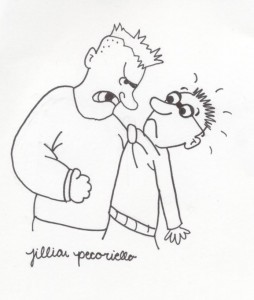
To an assistant principal, bullying is a violation of school rules and must be curbed with serious consequences. To a guidance counselor and social worker bullying is a problem that deeply affects both the victim and the bully. With each of these different perspectives there comes an important question: how does one deal with the bully?
Social workers are one group of Staples staff who constantly deal with bullies and the consequences of their actions.
“A bully is not only hurting his or her victim, either psychologically or physically,” said social worker Erin Morey, “but is also bringing negative consequences onto him or herself.”
Morey’s job is to talk with victims of bullies, but she also has to work with the bullies themselves. She advocates, “The more talking and communication we have with the bully, the better.”
All her conversations with students are confidential. When she does get involved, she often includes a follow-up with the assistant principal to record any progress.
Her counseling starts with an initial conversation with the bully. Then, if necessary there is long-term counseling.
The long-term discussions include conversations about empathy and anger management. On some rare occasions, the bully and victim are placed in the same room to talk things out with supervision.
Assistant Principal Karyn Morgan said that both parties consenting could be useful as it leads to a conflict resolution session with both the bully and victim in the same room.
“While some people do not feel comfortable doing this, when both want to, this is helpful because it bring closure to the situation,” she said.
“Bullying is often about power. Usually, the bully has been in a situation where they feel powerless and want to retaliate,” Morgan said.
With this in mind, both social workers and guidance counselors talk about home and friend situations with the bully to prevent any further problems.
Guidance counselor Victoria Capozzi explained that once, parents said that they were worried to come forward because they thought it may affect how the counselor proceeded in other aspects such as college admissions.
For example, the parent was concerned that the counselor would look negatively on the child and would therefore not be helpful in the college process.
“Counselors are very good at compartmentalizing things and can separate different aspects of a student,” Capozzi said.
Therefore, she hopes that students do come forward so the situation can be improved.
In terms of any bullying situations that are to be dealt with in guidance, Capozzi explained that it is not her job to pass judgment or make accusations.
“My office is a place of safety and my job it to try and have a conversation that makes the bully open up,” she said.
Capozzi starts by brainstorming where the bully’s actions may be coming from, and make it clear that it is not allowed.
Psychologists hold parent meetings, some of which are focused on bullying.
“We talk to parents about how they can support their children and help prevent bullying situations,” Psychologist Carol Taney said.
However, when bullying does occur the administration is the group of people who often must end up administrating punishment for bullying.
“From my position, bullying comes with a range of consequences that must be applied to each situation,” Assistant Principal Patrick Micinilio said.
“When bullying is reported, we must first initiate a serious investigation that may later result in suspension or possibly expulsion,” he said.
However, since bullying is such a serious accusation, Micinilio said that there cannot be a suspension just because of a report. He explained that they interview as many witnesses as possible that may know something about the situation including students, teachers, and paraprofessionals.
“Our first job is not to punish,” Morgan said. “We try to stop the behavior and then help the bully rather than just get the bully in trouble.”
According to Principal John Dodig, most bullying issues occur outside of school or on the Internet.
“Once these outside issues interfere with a student’s ability to come to school and learn, we are both legally and morally responsible to deal with the problem,” Dodig said.
Yet the problem intensifies when students do not want to report bullying situations that they see.
“The victim is often reluctant to come forward until the situation blows up,” Micinilio said.
Micinilio also explained that with the rare bullying cases he is faced with, when the word “bully” comes up, the behavior often stops because of the negative perception of being a bully.
Finally, if the situation does not improve after several warnings and suspensions, expulsion may be necessary, Micinilio said. For this, the situation must be presented in front of the expulsion hearing officer, which includes the assistant principals, the principal, the superintendent, the bully and victim’s family, and even a lawyer. This group listens to the argument and decides on a course of action.
“According to state statute, all students are entitled to a free and appropriate education. Anything that comes in the way of this must be dealt with in any necessary way, including expulsion,” Dodig said. “This is a big deal since it goes on the bully’s record and therefore, even if the bully does not feel remorse, the price is too big and the bully will stop.”
After any suspension or expulsion, the bully is also often referred to the counselors or social workers for extended discussion and further investigation into the situation.
“Dealing with bullying all depends on the situation but talking with the bully is often the best remedy. When bullies and victims open up, problems can be solved because we can only help when we know what’s going on,” Morey said.













































